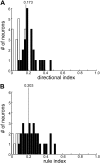Flexible interpretation of a decision rule by supplementary eye field neurons
- PMID: 21900513
- PMCID: PMC3234079
- DOI: 10.1152/jn.01134.2010
Flexible interpretation of a decision rule by supplementary eye field neurons
Abstract
Since the environment is in constant flux, decision-making capabilities of the brain must be rapid and flexible. Yet in sensory motion processing pathways of the primate brain where decision making has been extensively studied, the flexibility of neurons is limited by inherent selectivity to motion direction and speed. The supplementary eye field (SEF), an area involved in decision making on moving stimuli, is not strictly a sensory or motor structure, and hence may not suffer such limitations. Here we test whether neurons in the SEF can flexibly interpret the rule of a go/nogo task when the decision boundary in the task changes with each trial. The task rule specified that the animal pursue a moving target with its eyes if and when the target entered a visible zone. The size of the zone was changed from trial to trial in order to shift the decision boundary, and thereby assign different go/nogo significance to the same motion trajectories. Individual SEF neurons interpreted the rule appropriately, signaling go or nogo in compliance with the rule and not the direction of motion. The results provide the first evidence that individual neurons in frontal cortex can flexibly interpret a rule that governs the decision to act.
Figures






Similar articles
-
Contrasting the roles of the supplementary and frontal eye fields in ocular decision making.J Neurophysiol. 2014 Jun 15;111(12):2644-55. doi: 10.1152/jn.00543.2013. Epub 2014 Mar 26. J Neurophysiol. 2014. PMID: 24671543 Free PMC article.
-
A mechanism for decision rule discrimination by supplementary eye field neurons.Exp Brain Res. 2015 Feb;233(2):459-76. doi: 10.1007/s00221-014-4127-2. Epub 2014 Nov 5. Exp Brain Res. 2015. PMID: 25370345
-
Memory and decision making in the frontal cortex during visual motion processing for smooth pursuit eye movements.Neuron. 2009 Jun 11;62(5):717-32. doi: 10.1016/j.neuron.2009.05.010. Neuron. 2009. PMID: 19524530 Free PMC article.
-
The role of supplementary eye field in goal-directed behavior.J Physiol Paris. 2015 Feb-Jun;109(1-3):118-28. doi: 10.1016/j.jphysparis.2015.02.002. Epub 2015 Feb 23. J Physiol Paris. 2015. PMID: 25720602 Free PMC article. Review.
-
Contextual effects on motion perception and smooth pursuit eye movements.Brain Res. 2008 Aug 15;1225:76-85. doi: 10.1016/j.brainres.2008.04.061. Epub 2008 Apr 30. Brain Res. 2008. PMID: 18538748 Review.
Cited by
-
Preselection of potential target spaces based on partial information by the supplementary eye field.Commun Biol. 2024 Oct 4;7(1):1215. doi: 10.1038/s42003-024-06878-z. Commun Biol. 2024. PMID: 39367079 Free PMC article.
-
Smooth pursuit preparation modulates neuronal responses in visual areas MT and MST.J Neurophysiol. 2015 Jul;114(1):638-49. doi: 10.1152/jn.00636.2014. Epub 2015 May 27. J Neurophysiol. 2015. PMID: 26019315 Free PMC article.
-
Exploring the contributions of the supplementary eye field to subliminal inhibition using double-pulse transcranial magnetic stimulation.Hum Brain Mapp. 2017 Jan;38(1):339-351. doi: 10.1002/hbm.23364. Epub 2016 Sep 9. Hum Brain Mapp. 2017. PMID: 27611342 Free PMC article.
-
Contrasting the roles of the supplementary and frontal eye fields in ocular decision making.J Neurophysiol. 2014 Jun 15;111(12):2644-55. doi: 10.1152/jn.00543.2013. Epub 2014 Mar 26. J Neurophysiol. 2014. PMID: 24671543 Free PMC article.
-
A mechanism for decision rule discrimination by supplementary eye field neurons.Exp Brain Res. 2015 Feb;233(2):459-76. doi: 10.1007/s00221-014-4127-2. Epub 2014 Nov 5. Exp Brain Res. 2015. PMID: 25370345
References
-
- Barbas H, Pandya D. Patterns of connections of the prefrontal cortex in the rhesus monkey associated with cortical architecture. In: Frontal Lobe Function and Dysfunction, edited by Levin HS, Eisenberg HM, Benton AL. New York: Oxford Univ. Press, 1991, p. 35–58
-
- Brainard DH. The psychophysics toolbox. Spat Vis 10: 433–436, 1997 - PubMed
-
- Britten KH, Newsome WT, Shadlen MN, Celebrini S, Movshon JA. A relationship between behavioral choice and the visual responses of neurons in macaque MT. Vis Neurosci 13: 87–100, 1996 - PubMed
Publication types
MeSH terms
Grants and funding
LinkOut - more resources
Full Text Sources

